International Style (architecture)
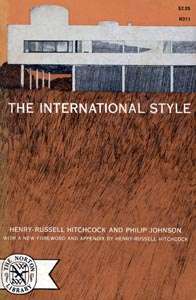
The International Style is the name of a major architectural style that is said to have emerged in the 1920s and 1930s, the formative decades of modern architecture, as first defined by Americans Henry-Russell Hitchcock and Philip Johnson in 1932, with an emphasis more on architectural style, form and aesthetics than the social aspects of the modern movement as emphasised in Europe. The term "International Style" first came into use via a 1932 exhibition curated by Hitchcock and Johnson, Modern Architecture: International Exhibition, which declared and labelled the architecture of the early 20th century as the "International Style". The most common characteristics of International Style buildings are said to be: i. rectilinear forms; ii. light, taut plane surfaces that have been completely stripped of applied ornamentation and decoration; iii. open interior spaces; iv. a visually weightless quality engendered by the use of cantilever construction. Glass and steel, in combination with usually less visible reinforced concrete, are the characteristic materials of the construction.[1]
With the surge in the growth in cities in the first half of the twentieth century, particularly after World War II, the International Style provided an easily achievable style option for vast-scale urban development projects, "cities within cities", intended to maximize the amount of floor space for a given site, while attempting to convince local planners, politicians and the general public that the development would bring much-needed wealth to the city while, on the other hand, rejecting the proposal would lead to the development being taken to a different, competing city.[2]
Etymology

In Europe the modern movement in architecture had been called Functionalism or Neue Sachlichkeit (New Objectivity), L'Esprit Nouveau, or simply Modernism and was very much concerned with the coming together of a new architectural form and social reform, creating a more open and transparent society.[3] The English term International Style originated from an exhibition in 1932 titled Modern Architecture: International Exhibition, curated by American architectural historian and critic Henry-Russell Hitchcock and recently graduated Harvard University philosophy student (and later self-taught architect) Philip Johnson. [4] Commissioned in 1931 by the founding director of the Museum of Modern Art, Alfred H. Barr Jr, this was the first ever architectural exhibition held at the Museum of Modern Art in New York, USA. The original exhibition catalogue was then followed up immediately by the book titled The International Style, which was reissued in 1966 with a new foreword by Hitchcock.[5]
The aesthetics-based definition of The International Style identified, categorized and expanded upon characteristics said to be common to Modernism across the world and its stylistic aspects. Hitchcock and Johnson identified three principles: the expression of volume rather than mass, the emphasis on balance rather than preconceived symmetry, and the expulsion of applied ornament. The aim of Hitchcock and Johnson was to define a style that would encapsulate this modern architecture, doing this by the inclusion of specific architects. All the works in the 1932 Museum of Modern Art exhibition were carefully selected, only displaying those that strictly followed these rules. For example, the works of the most prominent "modern" architect in the USA, Frank Lloyd Wright, was included in the exhibition only to provide a contrast to the International Style examples, and his works were not featured at all in the book that followed.[5]
Previous to the 1932 exhibition and book, Hitchcock had concerned himself with the themes of modern architecture in his 1929 book Modern Architecture: Romanticism and Reintegration, and the 1932 book can be seen as a supplement to the earlier book.[3] Both books, however, are seen as "operative texts" – in the understanding defined by Italian critic Manfredo Tafuri – in that they were not merely a history but moreover a kind of manifesto proclaiming the birth of a new architecture.[3]
Many Modernists disliked the term, believing that they had arrived at an approach to architecture that transcended "style", along with any national or regional or continental identity. The British architectural historian Sir Nikolaus Pevsner commented: "To me what had been achieved in 1914 was the style of the century. It never occurred to me to look beyond. Here was the one and only style which fitted all those aspects which mattered, aspects of economics and sociology, of materials and function. It seems folly to think that anybody would wish to abandon it."[6]
1932 MOMA exhibition
The exhibition Modern Architecture: International Exhibition opened on February 9, 1932, at the Museum of Modern Art (MoMA), in the Heckscher Building at Fifth Avenue and 56th Street in New York. Beyond a foyer and office, the exhibition was divided into six rooms: the "Modern Architects" section began in the entrance room, featuring a model of William Lescaze's Chrystie-Forsyth Street Housing Development in New York. From there visitors moved to the centrally placed Room A, featuring a model of a mid-rise housing development for Evanston, Illinois, by Chicago architect brothers Monroe Bengt Bowman and Irving Bowman,[7] as well as a model and photos of Walter Gropius's Bauhaus building in Dessau. In the largest exhibition space, Room C, were works by Le Corbusier, Ludwig Mies van der Rohe, J.J.P. Oud and Frank Lloyd Wright (including a project for a house on the Mesa in Denver, 1932). Room B was a section titled "Housing", presenting “the need for a new domestic environment” as it had been identified by historian and critic Lewis Mumford. In Room D were works by Raymond Hood (including "Apartment Tower in the Country" and the McGraw-Hill building) and Richard Neutra. In Room E was a section titled "The extent of modern architecture", added at the last minute,[4] which included the works of thirty seven modern architects from fifteen countries who were said to be influenced by the works of Europeans of the 1920s. Among these works was shown Alvar Aalto's Turun Sanomat newspaper offices building in Turku, Finland.
The exhibition is significant for its focused approach to the architectural exhibition. Highly curated in nature, the 1932 exhibition at was driven by a desire to promote and consolidate the theory of international modernism. As such, the exhibition featured prominently the work of the core of the modernist group. With Van Der Rohe, Corbusier, Oud, and Gropius at the forefront, the intention to solidify a core of ideals was clear. What is also clear is the way that the exhibition avoided reference to other contemporary styles that were exploring the boundaries of architecture at the time including German expressionism and the Organicist movement, popularized in the work of Antonio Gaudi. The significance to this lies in the relative perceived importance of these stylistic camps in the following architectural paradigm; as a result of the 1932 exhibition, the principles of International Modernism rose to the forefront, while other styles became ancillary to the story arc of the development of architectural style and theory.
Curators
MoMA's then director Alfred H. Barr hired art historians Philip Johnson and Henry-Russell Hitchcock to curate the museum's first architectural exhibition. In 1929, Johnson attended the graduation ceremony of his sister in Wellesley College, where he met Barr, who was teaching a course on modern art. In one month, Barr would be interviewed by Abby Aldrich Rockefeller for the position of the director of the MOMA, set to open its first gallery later that year. Barr added Johnson to MOMA's Junior Advisory Committee.
Hitchcock graduated in 1924 after having completed his undergraduate studies in three years and spending his senior year in architecture. At Harvard, he continued his graduate studies and got his master's degree in 1927.While at Harvard he met and built the relationship with Johnson. After graduation, Johnson traveled to Europe in where he met Hitchcock and the two began an extended tour of the continent.
During this tour, Hitchcock and Johnson met Barr in Hamburg. Barr was traveling with J.B.Neumann, a dealer in modern art with a gallery on East 57th street, and Cary Ross, a young poet and a member of the museum circle. Johnson related that "Alfred is most enthusiastic " about Hitchcock's book about modern art. As the project was in a state of formulation, Barr's reaction was critical. Johnson writes, "the text is getting bigger and bigger in our mind but also more important. We are discussing subjects which lie much nearer to my heart than most of the old ones, such as materials, construction, functionalism, and the fundamental aesthetic, especially of the style." Late August saw another important reference to the book: in explaining the difficulty in obtaining a German publisher Johnson comments that no one wants another book on modern architecture here in Germany...In vain do we explain that there has been no book covering the whole style and nothing but the style. Later there be any question of what exactly "the style" is, Otto Haesler, in responding to Johnson's request for photos, refers to "das Buch-the New International style 1922-1932". This transformation of the "old" book into a "more important" effort indicates that the broad outline of the familiar arguments of "the International Style" were then under discussion. The focused aesthetic arguments of that book are foretold in Johnson's description of the book as being "about the style and nothing but the style." By December 1930, the first written proposal for an exhibition of the "new architecture" was set down, yet the first draft of the book was not complete until some months later.
After a six-week run in New York City, the exhibition then toured the USA - the first such “traveling-exhibition” of architecture in the US - for six years.[8] As it is stated by Riley, in his 1992 book The International Style: Exhibition 15 and The Museum of Modern Art: "(I)ronically the (exhibition) catalogue, and to some extent, the book The International Style, published at the same time of the exhibition, have supplanted the actual historical event."[9] Through 1932 MOMA exhibition and its careful selection of international architects, curators Philip Johnson and Henry-Russell Hitchcock would guide the direction of Modern architecture, introducing the elements of their International style to architectural dialogue among architects and the general public. The exhibit Modern architecture would become synonymous with the use of steel and steel and reinforced concrete, uninterrupted interior spaces and simple geometric forms.
The following architects and buildings were selected by Hitchcock and Johnson for display at the exhibition Modern Architecture: International Exhibition:
| Architect | Building | Location | Date |
|---|---|---|---|
| Jacobus Oud | Workers Houses (house blocks Kiefhoek) | | 1924–1927 |
| Otto Eisler | Double House | | 1926–1927 |
| Walter Gropius | Bauhaus School | | 1926 |
| City Employment Office | | 1928 | |
| Ludwig Mies van der Rohe | Apartment House, Weissenhof Estate | | 1927 |
| German pavilion at the Barcelona Expo | | 1929 | |
| Tugendhat House | | 1930 | |
| Le Corbusier (Pierre Jeanneret) | Villa Stein | | 1927 |
| Villa Savoye | | 1930 | |
| Carlos de Beistegui Champs-Élysées Penthouse | | 1931 | |
| Erich Mendelsohn | Schocken Department Store | | 1928–1930 |
| Frederick John Kiesler | Film Guild Cinema | | 1929 |
| Raymond Hood | McGraw-Hill building | | 1931 |
| George Howe & William Lescaze | PSFS Building | | 1932 |
| Monroe Bengt Bowman & Irving Bowman | Lux apartment block | | 1931 |
| Richard Neutra | Lovell House | | 1929 |
| Otto Haesler | Rothenberg Siedlung | | 1930 |
| Karl Schneider | Kunstverein | | 1930 |
| Alvar Aalto | Turun Sanomat building | | 1930 |
Buildings featured in the 1932 MOMA exhibition
 Villa Savoye, Paris, Le Corbusier
Villa Savoye, Paris, Le Corbusier- Bauhaus, Dessau, Walter Gropius
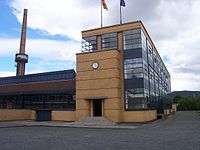 Fagus Factory, Alfeld, Walter Gropius
Fagus Factory, Alfeld, Walter Gropius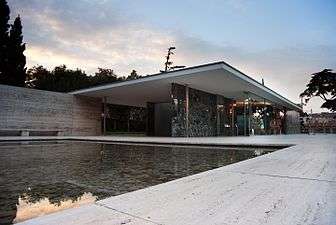 Barcelona Pavilion, Barcelona, Mies van der Rohe
Barcelona Pavilion, Barcelona, Mies van der Rohe.jpg) Villa Tugendhat, Brno, Mies van der Rohe
Villa Tugendhat, Brno, Mies van der Rohe Kiefhoek housing, Rotterdam, J.J.P. Oud
Kiefhoek housing, Rotterdam, J.J.P. Oud.jpg) Rothenberg Siedlung, Kassel, Otto Haesler
Rothenberg Siedlung, Kassel, Otto Haesler- Lovell House, Los Angeles, Richard Neutra
 McGraw-Hill Building, New York, Raymond Hood
McGraw-Hill Building, New York, Raymond Hood PSFS Building, Philadelphia, George Howe and William Lescaze
PSFS Building, Philadelphia, George Howe and William Lescaze Turun Sanomat, Turku, Alvar Aalto
Turun Sanomat, Turku, Alvar Aalto
Regions
Europe

Around 1900 a number of architects around the world began developing new architectural solutions to integrate traditional precedents with new social demands and technological possibilities. The work of Victor Horta and Henry van de Velde in Brussels, Antoni Gaudí in Barcelona, Otto Wagner in Vienna and Charles Rennie Mackintosh in Glasgow, among many others, can be seen as a common struggle between old and new. Hitchcock and Johnson do not see these architects, however, as part of the International Style because they are seen as retaining traces of an "individualistic manner"; that is, not so much the creators of a new style as the last representatives of Romanticism.[5]
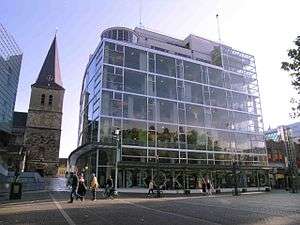
The "International Style", as defined by Hitchcock and Johnson, as such blossomed in 1920s Western Europe. Significant contemporary common ground is found among the activities of the Dutch De Stijl movement, works of the French/Swiss architect Le Corbusier, and various German efforts to industrialize craft traditions, which resulted in the formation of the Deutscher Werkbund, large civic worker-housing projects in Frankfurt and Stuttgart, and, most famously, the Bauhaus. The Bauhaus was one of a number of European schools and associations concerned with reconciling craft tradition and industrial technology for the purpose of bringing about change in society.
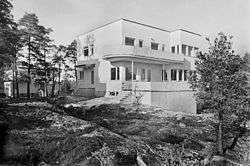
Le Corbusier had hoped that politically minded industrialists in France would lead the way with their efficient Taylorist and Fordist strategies adopted from American industrial models in order to reorganize society. In this new industrial spirit, Le Corbusier contributed to a new journal called L'Esprit Nouveau that advocated the use of modern industrial techniques and strategies to transform society into a more efficient environment with a higher standard of living on all socio-economic levels. He forcefully argued that this transformation was necessary to avoid the spectre of revolution that would otherwise shake society. His dictum "Architecture or Revolution", developed in his articles in this journal, became his rallying cry for the book Vers une architecture (Toward an Architecture), which comprised selected articles he contributed to L'Esprit Nouveau between 1920 and 1923.[10] Despite all the debate about increasing living standards, in favouring architecture over revolution, he laid the principle for the autonomy of architecture; that is, that architecture could be discussed in purely formal or aesthetic terms. Modern architecture, a truly international style, would serve any political position.
Thus, in terms of form, common characteristics of the International Style include: a radical simplification of form, a rejection of ornament, and adoption of glass, steel and concrete as preferred materials. Further, the transparency of buildings, construction (called the honest expression of structure), and acceptance of industrialized mass-production techniques contributed to the international style's design philosophy. Finally, the machine aesthetic, and logical design decisions leading to support building function were used by the International architect to create buildings reaching beyond historicism. The ideals of the style are commonly summed up in three slogans: ornament is a crime, truth to materials, form follows function; and Le Corbusier's description of houses as "machines for living".
In 1927, one of the first and most defining manifestations of the International Style was the Weissenhof Estate in Stuttgart, built as a component of the exhibition "Die Wohnung", organized by the Deutscher Werkbund, and overseen by Mies van der Rohe. The fifteen contributing architects included Mies, and other names most associated with the movement: Peter Behrens, Le Corbusier, Walter Gropius, J.J.P. Oud, Mart Stam, Bruno Taut and the less known young architect, Franz Krause. The exhibition was enormously popular, with thousands of daily visitors. However, there was also some critique: the Stuttgart “League for Heimat Protection” [Bund für Heimatschutz] referred to it as the “Arab village” (Araberdorf) - and a picture was made showing it looking like one - and called for it be torn down.
The gradual rise of the Nazi regime in Weimar Germany in the 1930s, and the Nazis' rejection of modern architecture, meant that an entire generation of avant-gardist architects, many of them Jews, were forced out of continental Europe. Some, such as Mendelsohn, found shelter in England, while a considerable number of the Jewish architects made their way to Palestine, and others to the USA. However, American anti-Communist politics after the war and Philip Johnson's influential rejection of functionalism have tended to mask the fact that many of the important architects, including contributors to the original Weissenhof project, fled to the Soviet Union. This group also tended to be far more concerned with functionalism and its social agenda. Bruno Taut, Mart Stam, the second Bauhaus director Hannes Meyer, Ernst May and other important figures of the International Style went to the Soviet Union in 1930 to undertake huge, ambitious, idealistic urban planning projects, building entire cities from scratch. In 1936, when Stalin ordered them out of the country, many of these architects became stateless and sought refuge elsewhere; for example, Ernst May moved to Kenya.[11]
- The town of Portolago (now Lakki) on the Greek Dodecanese island of Leros represents some of the most interesting urban planning from the fascist regime in the Dodecanese, a strand of modernist architecture often referred to Italian Rationalism. The symbolism of the shapes is reflected with exemplary effectiveness in the buildings of Lakki: the administration building, the metaphysical tower of the market, the cinema-theatre, the Hotel Roma (now Hotel Leros), the church of San Francisco and the hospital are fine examples of the style.
- The residential area of Södra Ängby in western Stockholm, Sweden, blended an international or functionalist style with garden city ideals. Encompassing more than 500 buildings, most of them designed by Edvin Engström, it remains the largest coherent functionalist or "International Style" villa area in Sweden and possibly the world, still well-preserved more than a half-century after its construction in 1933–40 and protected as a national cultural heritage.[12]
North America
Prior to use of the term 'International Style', the same striving towards simplification, honesty and clarity are identifiable in US architects, notably in the work of Louis Sullivan and Frank Lloyd Wright in Chicago, as well as the west-coast residences of Irving Gill. Frank Lloyd Wright's Wasmuth Portfolio had been exhibited in Europe and influenced the work of European modernists, and his travels there probably influenced his own work, although he refused to be categorized with them. In 1922, the competition for the Tribune Tower and its famous second-place entry by Eliel Saarinen gave some indication of what was to come, though these works would not have been accepted by Hitchcock and Johnson as representing the "International Style". Similarly, Johnson, writing about Joseph Urban's recently completed New School for Social Research in New York, stated: "In the New School we have an anomaly of a building supposed to be in a style of architecture based on the development of the plan from function and facade from plan but which is a formally and pretentiously conceived as a Renaissance palace. Urban's admiration for the New Style is more complete than his understanding."[4]
The same year that Hitchcock and Johnson coined the term International Style saw the completion of the world's first International Style skyscraper, Philadelphia's PSFS Building, and the building was indeed featured in the MoMA exhibition. Designed by the truly "international" team of architects, George Howe and William Lescaze, the PSFS Building has become an integral element of the Philadelphia skyline.
Frank Lloyd Wright's work was considered a formative influence on the international style, but he was considered not to have kept up with more recent developments. His work was included in the exhibition, but not the catalogue or book. This provoked Wright to quip in response to Hitchcock and Johnson "...having a good start, not only do I fully intend to be the greatest architect who has yet lived, but fully intend to be the greatest architect who will ever live". His buildings of the 1920s and 1930s clearly showed a change in the style of the architect, but in a different direction than the International Style.
With the rise of Nazism, a number of key European modern architects fled to the USA. When Walter Gropius and Marcel Breuer fled Germany they both arrived at the Harvard Graduate School of Design, in an excellent position to extend their influence and promote the Bauhaus as the primary source of architectural modernism. When Mies fled in 1938, he first fled to England, but on emigrating to the USA he went to Chicago, founded the Second School of Chicago at IIT and solidified his reputation as a prototypical modern architect.
After World War II, the International Style matured, Hellmuth, Obata & Kassabaum (later renamed HOK) and Skidmore, Owings & Merrill (SOM) perfected the corporate practice, and it became the dominant approach for decades in the US and Canada. Beginning with the initial technical and formal inventions of 860-880 Lake Shore Drive Apartments in Chicago its most famous examples include the United Nations headquarters, the Lever House, the Seagram Building in New York City, and the campus of the United States Air Force Academy in Colorado Springs, Colorado, as well as the Toronto-Dominion Centre in Toronto. Further examples can be found in mid-century institutional buildings throughout North America and the "corporate architecture" spread from there, especially to Europe.
In Canada, this period coincided with a major building boom and few restrictions on massive building projects. International Style skyscrapers came to dominate many of Canada's major cities, especially Ottawa, Montreal, Vancouver, Calgary, Edmonton, Hamilton, and Toronto. While these glass boxes were at first unique and interesting, the idea was soon repeated to the point of ubiquity. A typical example is the development of so-called Place de Ville, a conglomeration of three glass skyscrapers in downtown Ottawa, where the plans of the property developer Robert Campeau in the mid 1960s and early 1970s - in the words of historian Robert W. Collier, "forceful and abrasive, he was not well-loved at City Hall" - had no regard for existing city plans, "built with contempt for the existing city and for city responsibilities in the key areas of transportation and land use".[2] Architects attempted to put new twists into such towers, such as the Toronto City Hall by Finnish architect Viljo Revell. By the late 1970s a backlash was under way against modernism — prominent anti-modernists such as Jane Jacobs and George Baird were partly based in Toronto.
The typical International Style or "corporate architecture" high-rise usually consists of the following:
- Square or rectangular footprint
- Simple cubic "extruded rectangle" form
- Windows running in broken horizontal rows forming a grid
- All facade angles are 90 degrees.
Israel
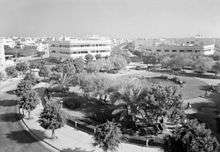
In July 1994, UNESCO proclaimed the White City of Tel Aviv a World Heritage Site, describing the city as "a synthesis of outstanding significance of the various trends of the Modern Movement in architecture and town planning in the early part of the 20th century".[13] Tel Aviv was founded in 1909 by European Jewish settlers, who erected the first buildings on sand dunes outside the inhabited ancient Arab town of Jaffa.[14] A large proportion of the buildings built in the International Style can be found in the area planned by Patrick Geddes, north of Tel Aviv's main historical commercial center. Geddes laid out the streets and decided on block size and utilization. His plan was to create a garden city, but in a more compact form than in England.[15] He did not prescribe an architectural style for the buildings in the new city, though he himself favoured architectural eclecticism. The impetus for large-scale construction in the new style came from the rapid influx of European Jewish immigrants (who grew in numbers from about 2,000 in 1914 to about 150,000 in 1937).[16] In the 1930s, new architects and architectural ideas were to converge on Tel Aviv to satisfy a burgeoning, relatively prosperous population with European tastes.
By 1933 many Jewish architects who had studied at the German Bauhaus school, which was closed down on the orders of the Nazi Party, fled to the British Mandate of Palestine.[18] But there were also other architects arriving from the Soviet Union, Ukraine and Poland, but had studied in avant-gardist schools in Moscow, France and Italy. The residential and public buildings were designed by these architects, who took advantage of the absence of established architectural conventions to put the principles of modern architecture into practice. The Bauhaus principles, with their emphasis on functionality and inexpensive building materials, were perceived as ideal in Tel Aviv. The architects fleeing Europe combined their Bauhaus or Functionalist ideas with the architectural ideals of Le Corbusier. Among notable architects were Erich Mendelsohn, who belonged to the Expressionist school and who was active in Jerusalem in the 1930s, Carl Rubin, who had worked in Mendelsohn's office,[19] Oskar Kaufmann, Jehuda Magidovitch, Dov Karmi, Zeev Rechter, Richard Kaufmann and Arieh Sharon.[20]
In 1984, in celebration of Tel Aviv's 75th year,[21] an exhibition was held at the Tel Aviv Museum of Art entitled White City, International Style Architecture in Israel, Portrait of an Era, which continued to travel the world afterwards. In 1994, a conference took place at the UNESCO headquarters, entitled World Conference on the International Style in Architecture. In 1996, Tel Aviv's White City was listed as a World Monuments Fund endangered site.[22] In 2003, UNESCO named Tel Aviv a World Heritage Site for its treasure of modern architecture.[13]
Other countries
One of the strengths of the International Style has been said to be that the design solutions were indifferent to location, site, and climate; the solutions were supposed to be universally applicable; the style made no reference to local history or national vernacular. This was soon identified as one of the style's primary weaknesses. Indeed, already at the same time as key "International Style" works were being built, some architects were already adapting it to local conditions. A key example is that of Finnish architect Alvar Aalto, the influential critic Sigfried Giedion saying that "Finland is with Aalto wherever he goes".[23]
In the preface to the 2007 fourth edition of his book Modern Architecture - A Critical History, Kenneth Frampton argues that there has been a "disturbing Eurocentric bias" in received histories of modern architecture. This "Eurocentrism" includes the USA.[24] So while, on the one hand, a number of key European avant-gardist architects would with the rise of Nazism, fleeing to England, Sweden, Palestine, Soviet Union and USA, there would also be "indigenous" modernist groups in Mexico, the Middle East, India, Central America, South America and Africa.
- In 2000 UNESCO proclaimed Ciudad Universitaria de Caracas in Caracas, Venezuela, as a World Heritage Site, describing it as "a masterpiece of modern city planning, architecture and art, created by the Venezuelan architect Carlos Raúl Villanueva and a group of distinguished avant-garde artists".
- In June 2007 UNESCO proclaimed Ciudad Universitaria of the Universidad Nacional Autónoma de México (UNAM), in Mexico City, a World Heritage Site due to its relevance and contribution in terms of international style movement (as well as cultural - alma mater of 3 Nobel Prize winners and most Mexican presidents). It was designed in the late 1940s and built in the mid-1950s based upon a masterplan created by architect Enrique del Moral. His original idea was enriched by other students, teachers, and diverse professionals of several disciplines. The university houses murals by Diego Rivera, Juan O'Gorman and others. The university also features Olympic Stadium (1968). In his first years of practice, Pritzker Prize winner and Mexican architect Luis Barragán designed buildings in the International Style. But later he evolved to a more traditional local architecture. Other notable Mexican architects of the International Style or modern period are Carlos Obregón Santacilia, Augusto H. Alvarez, Mario Pani, Federico Mariscal, Vladimir Kaspé, Enrique del Moral, Juan Sordo Madaleno, Max Cetto, among many others.
- In Brazil Oscar Niemeyer proposed a more organic and sensual[25] International Style. He designed the political landmarks (headquarters of the three state powers) of the new, planned capital Brasilia. The masterplan for the city was proposed by Lucio Costa.
Criticism of International Style
The stark, unornamented appearance of the International Style met with contemporaneous criticism and is still criticized today by many. Especially in larger and more public buildings, the style is commonly subject to disparagement as ugly,[26] inhuman,[27] sterile,[28] and elitist.[29] Such criticism gained momentum in the latter half of the 20th Century, from academics such as Hugo Kükelhaus to best-selling American author Tom Wolfe's From Bauhaus to Our House, and contributed to the rise of such counter-movements as postmodernism. The negative reaction to internationalist modernism has been linked to public antipathy to overall development.[30][31]
Although it was conceived as a movement that transcended style, the International Style was largely superseded first by more localised variations that took into account locality and site and later by so-called Postmodern architecture that started in the 1960s. In 2006, Hugh Pearman, the British architectural critic of The Times, observed that those using the style today are simply "another species of revivalist", noting the irony.[6]
Other major examples of International Style architecture
Architects
- Alvar Aalto
- Max Abramovitz
- Luis Barragán
- Welton Becket
- Geoffrey Bazeley
- Max Bill
- Marcel Breuer
- Roberto Burle Marx
- Gordon Bunshaft
- Natalie de Blois
- Henry N. Cobb
- George Dahl
- Charles and Ray Eames
- Otto Eisler
- Joseph Emberton
- Heydar Ghiai
- Landis Gores
- Bruce Graham
- Eileen Gray
- Walter Gropius
- Wallace Harrison
- Hermann Henselmann
- Raymond Hood
- George Howe
- Mazharul Islam
- Arne Jacobsen
- Marcel Janco
- John M. Johansen
- Philip Johnson
- Louis Kahn
- Dov Karmi
- Oskar Kaufmann
- Richard Kaufmann
- Fazlur Khan
- Frederick John Kiesler
- Le Corbusier
- William Lescaze
- Charles Luckman
- Yehuda Magidovitch
- Michael Manser
- Alfred Mansfeld
- Erich Mendelsohn
- John O. Merrill
- Hannes Meyer
- Ludwig Mies van der Rohe
- Richard Neutra
- Oscar Niemeyer
- Eliot Noyes
- Gyo Obata
- Jacobus Oud
- Nathaniel A. Owings
- Mario Pani
- I.M. Pei
- Frits Peutz
- Ernst Plischke
- Ralph Rapson
- Zeev Rechter
- Gerrit Rietveld
- Carl Rubin
- Rudolph Schindler
- Michael Scott
- Arieh Sharon
- Louis Skidmore
- Jerzy Sołtan
- Raphael Soriano
- Edward Durell Stone
- Carlos Raul Villanueva
- Leendert van der Vlugt
- Lloyd Wright
- Minoru Yamasaki
- The Architects' Collaborative
See also
Further reading
- Stefan Boness, "Tel Aviv - The White City", Jovis, Berlin 2012, ISBN 978-3-939633-75-4
- Henry Russell Hitchcock and Philip Johnson, The International Style, W. W. Norton & Company, New York, 1997 (originally published 1935).
- Terence Riley, The International Style: Exhibition 15 and The Museum of Modern Art, Rizzoli, New York, 1992.
- John Elderfield (ed), Philip Johnson and the Museum of Modern Art, Museum of Modern Art, New York, 1998.
- Gabriel Gössel, Functional Architecture. Funktionale Architektur. Le Style International. 1925-1940, Taschen, Berlin, 1990.
- Baharak Tabibi, Exhibitions as the Medium of Architectural Reproduction - "Modern Architecture: International Exhibition", Department of Architecture, Middle East Technical University, 2005.
References
- ↑ "International Style", Encyclopedia Britannica, 2005.
- 1 2 Robert W. Collier, Contemporary Cathedrals - Large scale developments in Canadian cities, Harvest House, Montreal, 1975.
- 1 2 3 Panayotis Tournikiotis, The Historiography of Modern Architecture, MIT Press, Cambridge, Mass., 1999. ISBN 0-262-70085-9.
- 1 2 3 Terence Riley, "Portrait of the curator as a young man", in John Elderfield (ed), Philip Johnson and the Museum of Modern Art, Museum of Modern Art, New York, 1998, pp.35-69
- 1 2 3 Henry Russell Hitchcock, Philip Johnson. The International Style. W. W. Norton & Company, 1997. ISBN 0-393-31518-5
- 1 2 Gabion: Modernism - or should that be Modernwasm?
- ↑ Monroe Bengt Bowman (1901-1994), Art Institute Chicago
- ↑ Baharak Tabibi, Exhibitions as the Medium of Architectural Reproduction - "Modern Architecture: International Exhibition", Department of Architecture, Middle East Technical University, 2005.
- ↑ Terence Riley, The International Style: Exhibition 15 and The Museum of Modern Art. New York, Rizzoli, 1992.
- ↑ Le Corbusier. Toward an Architecture. Translated by John Goodman. Los Angeles: Getty Research Institute, 2007.
- ↑ Claudia Quiring, Wolfgang Voigt, Peter Cachola Schmal, Eckhard Herrel (eds), Ernst May 1886-1970, Munich, Prestel, 2011.
- ↑ Detailed references listed in the article on Södra Ängby.
- 1 2 White City of Tel-Aviv – the Modern Movement, World Heritage Centre, Unesco, retrieved 2009-09-14
- ↑ Jewish Virtual Library. The Founding of Tel Aviv. Accessed 25 February 2010.
- ↑ The New York Times. A City Reinvents Itself Beyond Conflict. Accessed 25 February 2010.
- ↑ Jewish Virtual Library. From Spring Hill to Independence. Accessed 25 February 2010.
- ↑ Cinema Treasures, Esther Cinema, Tel Aviv Israel, Accessed 1 March 2010
- ↑ Ina Rottscheidt, Kate Bowen, Jewish refugees put their own twist on Bauhaus homes in Israel, Deutsche Welle, 1 April 2009
- ↑ UNESCO, Advisory Body Evaluation: Tel Aviv (Israel) No 1096, p. 57, retrieved 14 September 2009
- ↑ Sharon Architects, Three Generations of Sharon Architects – A Historical Summary accessed 29 March 2009
- ↑ Goel Pinto, Taking to the streets – all night long, Haaretz, 29 June 2007
- ↑ World Monuments Fund, World Monuments Watch 1996–2006, retrieved 16 September 2009
- ↑ Sigfried Giedion, Space, Time and Architecture: The growth of a new tradition, Harvard University Press, Cambridge, 1949.
- ↑ Kenneth Frampton, Modern Architecture - A Critical History, London, Thames and Hudson, 2007.
- ↑ Botey, Josep (1996). Oscar Niemeyer. Barcelona: Gustavo Gili. ISBN 8425215765.
- ↑ Philip S. Gutis, It's Ugly, And So Is The Fight To Save It, New York Times, February 7, 1987, accessed 02-17-2008
- ↑ E.g., C. Thau & K. Vindum, Jacobsen, 2002, at 65, ISBN 978-87-7407-230-0 (referring to reaction to internationalism as "A Horror of the Traceless, Inhuman Industrial Look") Archived February 27, 2008, at the Wayback Machine.
- ↑ A History of Architecture, New Internationalist issue 202 - December 1989
- ↑ T. Wolfe, From Bauhaus to Our House, Farrar Straus Giroux (1981), ISBN 978-0-374-15892-7 ISBN 0-374-15892-4
- ↑ Herbert Muschamp, Fear, Hope and the Changing of the Guard, New York Times, November 14, 1993, accessed 02-17-2008 ("the preservation movement . . . was a tool directed against real estate development, but inevitably it was turned against architecture. Its particular target was modern architecture")
- ↑ R. Jobst, Charm is not an antiquated notion, FFWD Weekly: March 31, 2005 ("At the root of the public's apprehension about new development is that we've been getting screwed for 60 years by brutal, soulless and downright crappy architecture that arrogantly dismisses the human requirement for beauty")
| Wikimedia Commons has media related to International style. |